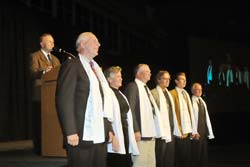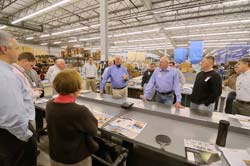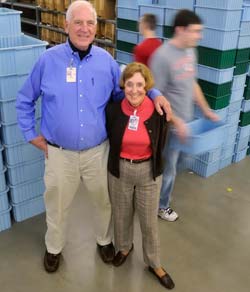A half-century training legacy
Sporty's Pilot Shop marks its fiftieth anniversary
A new twist on training?
When the FAA introduced the recreational pilot certificate in 1989, Shevers saw it as an easier way for student pilots to earn a certificate, providing an important milestone and allowing them to more quickly share the joy of flying with family and friends. Sporty’s Academy students—even those enrolled in the University of Cincinnati flight program—routinely earn the recreational pilot ticket first, and quickly add on the private.
Now, Shevers is emphasizing the first solo. “Most students walk in and ask for a private [certificate], but what they really want is to solo,” he says. “We make a big deal of the solo around here.” There’s a celebration when the shirttails are cut, and a second one later, when the shirttails—framed by the flight school—are returned to the student.
“The way it is today, after you solo, another thousand bucks and you’re a recreational pilot. Then, another $1,000 and you’re a private pilot. The private pilot today is such a long tunnel. This is a building-block approach, just like you don’t start school in the eighth grade.”
Shevers wishes the recreational pilot had the same self-certification medical requirements as sport and glider pilots. “That would do more for this industry, and the solo course, than anything else.” —MPC
The trainer that almost…wasn’t
Do you remember the Sporty’s Hawk? “In the early 1990s we came up with the Hawk project, which was essentially to clone the [Cessna] 172,” Shevers says. Cessna had halted piston-aircraft production in 1986 because of product liability concerns, and the training fleet was aging. “[Then-Cessna CEO] Russ Meyer came out and said, ‘If we ever get a statute of limitations, we will start building again.’”
Thanks to an industrywide effort, the General Aviation Revitalization Act was passed in 1994. Cessna put the Skyhawk back into production—and Sporty’s didn’t. “We wanted to find out what the market really was, and who was going to do what. So the Hawk project was successful. It was all bull, but it was very successful,” Shevers recalls. “Russ is a man of his word. And it was the beginning of a great friendship with Russ.”
Although the Hawk was a bluff, it almost turned into “the real deal” with an offer to buy Piper Aircraft out of bankruptcy in the mid-1990s. “We had the money in place to buy Piper. But the investment bankers thought the price should be higher, which derailed the deal.” And looking back, Shevers is not at all unhappy with that outcome. —MPC
Weekdays usually start out slowly at Clermont County Airport in Batavia, Ohio, just east of Cincinnati. When the weather’s good—especially during the warmer months, when the days are longer—several flight-school airplanes are aloft when the Sporty’s Pilot Shop crew begins rolling into the parking lot.
Around 9:15 a.m., people begin to gather amid several large tables in the front of the warehouse, near the offices. The morning’s mail is sorted and discussed until 9:30, when the standup morning meeting begins. Key employees recap the previous day and look ahead—industry events, upcoming trips, order volumes, normally in 10 to 15 minutes. The routine hasn’t changed much since the company moved into its current facility in 1990. Sporty’s history goes back to 1961, however, and the company is marking its fiftieth anniversary in 2011.
Afterwards, the Sporty’s management team gathers for a second meeting—in chairs—around founder and Chairman Hal Shevers’ desk in the open office area. “The purpose of this meeting is to let them know what I’m doing, so I don’t mess anything up,” Shevers quips.
At the second meeting, Shevers pursues the focus on customer service that has helped the company survive and grow over five decades. A customer called looking for a replacement cord for an older, name-brand headset and was told it was unavailable, he says. “We didn’t have it and don’t want to get it? Who’s going to follow up on this?”
Shevers founded the business in 1961, initially selling pilot supplies from the trunk of his car. “Now I’m director of turbine operations. That’s my retirement job.” Michael Wolf—an employee since 1972—has been the company’s president since 2003. Shevers and his wife, Sandy, have sold the business to a group of key longtime employees.
Reflecting on his tenure, Shevers rattles off several high points—marrying Sandy, becoming a Distinguished Eagle Scout, receiving the first Friends of Meigs Trophy, being inducted into the Flight Instructor Hall of Fame at the EAA AirVenture Museum in Oshkosh, earning his ATP certificate, being catapulted off the aircraft carrier U.S.S. Ronald Reagan. He fondly recalls his first time teaching for the AOPA Air Safety Foundation. “Ralph Nelson called in 1963 and asked me to come out to Palm Springs to teach at the AOPA Plantation Party,” a predecessor to today’s AOPA Aviation Summit, for what’s now the AOPA Air Safety Institute. “Then I ended up as the instrument refresher course supervisor.”
Click the image for a larger version.Sandy Shevers, who married Hal in 1965, started working part-time at Sporty’s in November 1975. “I never actually worked full-time here, officially. But I’ve put in a lot of hours,” she says. “When I first started we weren’t on the computer yet—all the orders were taken by hand.” Computerization came in 1982. A longtime director of the company, she handles a lot of editing, personnel administration, and writes an employee newsletter, which “says it’s published sporadically—we’re traveling,” she laughs.
She never expected Sportsman’s Market—the parent corporation of Sporty’s Pilot Shop and its other activities—to grow like it did. “It’s been amazing, really. Even when I started at Sporty’s in late 1975, there were only about 20 or 25 people here.” Today, employment is about 170.
 Returns are handled every morning. The pilot shop prides itself on processing returns the day they’re received. The task is completed in a small flurry of activity before noon.
Returns are handled every morning. The pilot shop prides itself on processing returns the day they’re received. The task is completed in a small flurry of activity before noon.
Not everything has gone as well as the returns process, however. “Of the 50 years, the last two were as tough as we’ve ever had,” Shevers notes. “I never envisioned this.”
“It was very traumatic to think that the company could fail,” Sandy Shevers adds.
“The lowest point was when we had a double fatality in the flight school,” Hal Shevers continues. That taught him how tough it is to get flight instructors to follow the rules. “We’re all kind of rogue guys who think we can do it best.” One of his flight school managers’ main jobs today is maintaining enough camaraderie with the instructors to know what they’re doing.
And the economy appears to be turning the corner. “We’ve never had business drop off the way it did,” falling 40 percent—and leading to the company’s first-ever layoffs. “We were in business 48 years before we ever had to have a layoff,” Shevers says. “We’re almost back to where we were three years ago.”
Sporty’s managers often eat lunch together in the large, second-floor lunchroom. Look for them at tables near the window, where they can watch flight activity as they talk. Food comes from a large circular vending machine dubbed “The Wheel of Death,” but most of the choices are remarkably edible. Beware of the microwave burritos, however.
Communication has always been the key. When Shevers became an instrument flight instructor, most of his customers were World War II-era pilots without instrument ratings. “I listened to what they wanted to buy—what they needed.”
Sporty’s first product was a radio receiver that picked up control towers, so pilots could listen and improve their phraseology. At first Shevers, who was working for Cincinnati Milling Machine, sold the $37.95 Realtone radios from the trunk of his car. Another early innovation customers sought was a headset with a boom mic. “It was the Plantronics boom mic. It hasn’t changed much since. I think we really pioneered the boom mics.”
At an AOPA Plantation Party in Tampa, John Deye won a Sanderson 360-Degree Course—complete with filmstrips and phonograph records. “He said, ‘I don’t know what I’m going to do with this’—so he gave it to me,” recalls Shevers, who used it to put on a ground school; 100 people showed up.
Pleased by the results, he obtained a Sanderson instrument course. “We locked four guys in a building at Lunken [Municipal Airport in Cincinnati] for three days, and they all passed.” That was the beginning of the three-day ground school, which became his full-time job in 1966. Joe Vorbeck, then chairman of general aviation technology at Purdue University, reworked the course. “He really helped us shape up the three-day ground school,” Shevers recalls.
 “In July I’ll have been a flight instructor for 50 years. And that’s what Sporty’s really is. It makes my day when somebody solos and we get to cut off their shirttails.”
“In July I’ll have been a flight instructor for 50 years. And that’s what Sporty’s really is. It makes my day when somebody solos and we get to cut off their shirttails.”
The company’s specialty is core training—private, recreational, and instrument ground-school courses, he says. They became available on VHS tapes in 1988, and were released on DVD in 2001—and today they can be downloaded to your personal computer, iPad, or iPhone. “The products come about because we really fly. We have 14 airplanes on the line. We don’t just tell people how to run their flight schools, we run one.”
Sporty’s also manages Clermont County Airport, where it’s based; in addition to the flight school, the company provides FBO and maintenance services, owns an avionics shop, and is developing a residential airpark, Sandy’s Farm, at the airport.
The company publishes five catalogs—offering tools, lifestyle products, and aviation supplies—although 80 percent of orders come from the pilot shop. The pilot shop catalog includes more than 7,000 items ranging from charts and flight bags to headsets, GPSs, and leather flight jackets. By midafternoon, warehouse activity is picking up. Pullers, many of them high-school and college students working part time, take order printouts, find each item, and put them in a plastic tray. After a quality-control check, they’re whisked to packing stations, where they’re boxed, addressed, and placed on a conveyor belt. At the end of the belt they get shipping labels; most continue down another conveyor and begin to fill a UPS trailer that was empty a couple hours ago. The process is repeated as the company ships 2,000 to 5,000 orders each weekday.
Philanthropy always has been important to both Hal and Sandy Shevers, and they’ve long supported a number of aviation causes. In March 2007 they launched the Sporty’s Foundation. The 501(c)(3) charitable organization has provided funds to the EAA Young Eagles program, the AOPA Air Safety Institute, National Intercollegiate Flying Association, National Air and Space Museum, and scholarships supporting the Boy Scouts of America Aviation Exploring program, University of Cincinnati Aviation, and the Aircraft Electronics Association. Other contributions have supported youth-related facilities and education programs at AirVenture and Sun ’n Fun.
 In its support for the Young Eagles program, Sporty’s has given away more than 6,000 complete private pilot ground-school courses. Now, participating youth are becoming eligible for a free first flight lesson. “It just started in the fall with a soft launch,” explains Mark Wiesenhahn of Sporty’s. “This spring should see a big increase.”
In its support for the Young Eagles program, Sporty’s has given away more than 6,000 complete private pilot ground-school courses. Now, participating youth are becoming eligible for a free first flight lesson. “It just started in the fall with a soft launch,” explains Mark Wiesenhahn of Sporty’s. “This spring should see a big increase.”
Sporty’s has contributed to the size of the GA aircraft fleet as well, awarding 28 sweepstakes airplanes over the past 25 years. The winner of the next one, a Cessna Skycatcher light sport airplane, will be drawn in May.
Around 6 p.m., UPS picks up the loaded trailer, and the merchandise begins the journey to its new owners. The Sporty’s crew follows the brown truck down Sporty’s Drive toward Taylor Road. But the airport’s never quiet. After the last airplane is tied down, a watchman patrols the facility until dawn. And you can bet his report will be discussed at the next morning’s 9:30 standup meeting, even if it includes nothing more nefarious than deer sightings.
What is Shevers’ wish going forward? “I hope the new owners do better than I did, and have more fun doing it,” he says. “It’s been very satisfying.”
E-mail the author at [email protected]



